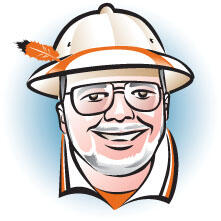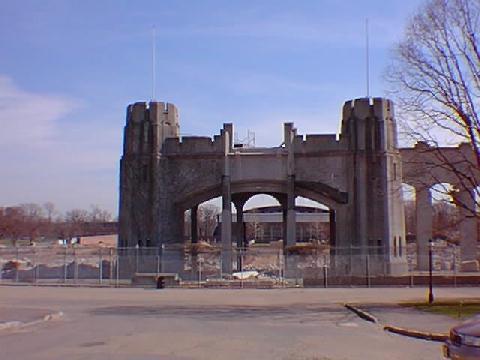Rally 'Round the Cannon
A century of football: With each new coach, new programs and new hopes
Over the last century, bucolic Princeton in its fall glory has developed and enriched priceless traditions celebrating the return to campus, the beginnings of a fresh school year, and the unbridled optimism of full-blown academic fancy. These include the wonderful Cane Spree (although for some reason, few recent participants seem to end up in the hospital), the pageantry of Opening Exercises, the new fun-with-frosh (*EXCUSE* me, “first-year students”) Pre-rade and freshman step sing, the somber announcements of the year’s Princeton MacArthur fellows and Nobel Prize winners, the semi-tolerance of parents’ weekend, and of course the matchless beauty of the Tiger National Holiday, Halloween.
But all these, poignant and profane, glorious and gory, pale when compared to our greatest periodic fall ceremony, the Welcoming of the New Football Coach (NFC).
Or, as we are taught in Sports Media 101 to say these days, the Changing of the Program (COP). I waited to mention it until you were comfortable with this year’s NFC/COP (hi, Bob Surace ’90!), but since we’re now wrapping up our current iteration, with the inevitable disappointment-mixed-with-hope, I thought it would be instructive to look back over the legacy of “programs” past to recall that, no matter what (or whether) you think about a new coaching staff’s baptism by fire, you have some historical precedent to back you up.
Palmer Stadium goes up in 1914 (a new coach would be hired a year later).
In 1914, the year Palmer Stadium opened with a loss to (of course) Yale, the long-traditional Alumni Football Committee approach to running the team (rather like the Spanish Inquisition without the incense) collapsed of its own backbiting, and the following year the first truly independent coach, Speedy Rush 1898 was hired. He went 6-2, but the losses were to Harvard and Yale (by a total of only 10 points, to be fair), by today’s standards a glorious success. After the interruption of World War I, he was not brought back.
Bill Roper 1902, a fiery and intuitive leader, had been the volunteer alumnus coach for five years under the committee, including the undefeated 1911 team, and having made his financial pile in Philadelphia, he was lured back full time to return the Tigers to glory. In the kerfuffle of reorganizing the post-mobilization campus in 1919, he went 4-2-1, but (you’ll hear this often) beat Yale (for the first time since that same 1911 team) and so became a hero.
By 1930, the new semi-pro football era of Amos Alonzo Stagg and Knute Rockne had passed by the impulsive Roper. He resigned with a record 89 wins (unmatched since), and in 1931 his ex-assistant Al Wittmer ’22 (who had won a national championship as basketball coach in 1925) got destroyed to the tune of 1-7, including a historic 51-14 disaster in New Haven. Poof. This precipitated a truly big-time NFC/COP, with non-alum Fritz Crisler (a Stagg disciple) imported from Minnesota – with his assistants!! – for the most memorable 2-2-3 season in the history of Princeton sports, including an epic 7-7 tie with Yale. When he left after six spectacular years for increased power at Michigan, his assistant Tad Wieman inherited the team but couldn’t match Crisler’s gaudy 35-9-5 record. After World War II, Wieman didn’t return. In fact, Wieman’s most notable achievement was bringing in a young assistant coach from Michigan (ironically forced out of his assistant athletic director’s job there by Crisler) who took over the Tiger basketball team in 1938 – Cappy Cappon. In contrast to football, that “program” continues to this day, coach-to-student, an astonishing 73 seasons later.
In 1945, the next NFC/COP brought in Charlie Caldwell ’25, who had played for Roper (and against Stagg), and while coaching at Williams had beaten Princeton 19-7 in 1942. A classic single-wing coach, he blew his first Tiger season completely by using the T-formation for some reason and finished 2-3-2. In the chaos of the war’s end, however, most of his team graduated Nov. 1, before the 20-14 Yale loss, so nobody blamed him much. Chastened, he switched back to the single wing the next year, and he and his protégé Dick Colman then went 143-60-1 with it over the next 23 years, the Golden Age of Princeton football. Their student, Jake McCandless ’51, switched back to the T, but after an initial Ivy title in 1969, the program fell apart.
So 1973 saw the first NFC/COP of the formal Ivy era. The siren call of the Caldwell/Colman afterglow was still strong, and another of their students, Bob Casciola ’58, was brought in from Connecticut. With a cupboard bare of talent, his first year was calamitous, a 1-8 mess that included no wins over any Ivy opponent for the first time since 1931. Five years later, Casciola was gone after no winning seasons.
One of the truly curious NFC/COP choices in Tiger history came next. Frank Navarro, well-liked but previously canned after going 16-36-2 at Columbia, came in from exile at Wabash and finished 2-5-2 in 1978, essentially no change from Casciola. But he loved offense, and his passing attack featuring Bob Holly beat Yale 35-31 in 1981 (neither McCandless nor Casciola ever did) in one of Princeton’s most memorable games ever. His team was fun to watch, and that earned him seven years at the helm despite an overall losing record.
Ron Rogerson then was brought in from Maine in 1985. It is instructive that virtually nobody (probably including the players) recalls he went 5-5 that year, although that was the best record by a brand-new staff since 1932. What they remember is the bonfire, the first since (steady, now) 1966. No one even knew how to build one anymore. That alone, plus his untimely death from a heart attack at 44 two years later, assured Rogerson of a unique spot in the pantheon. His assistant, Steve Tosches, took over for him, becoming Princeton’s first winning coach since 1972 following a 6-4 initial season played emotionally in memory of Rogerson. Tosches actually won more games (78) than either Caldwell or Colman, lasting 13 years before a creaky offense and reputed friction with the admission office took its toll. NFC/COP.
Palmer Stadium comes down in 1997 (a new coach would be hired two years later).
So in 2000 came Roger Hughes from Dartmouth, where as offensive coordinator he had incubated quarterback Jay Fiedler to pro-dom. He instantly increased offensive production by a touchdown per game, but his first season was 3-7, the same as Tosches’ last (albeit with a nice win in the Yale Bowl). The rest of his 10-year tenure (say that five times fast) you know well from the breathtaking pages of Your Favorite Periodical. He ended as the fourth overall losing coach in the last 39 years of Princeton football (only Tosches was over .500); in that period since the Caldwell/Colman/McCandless era, four “programs” together have gone 175-180-6, managing after all the angst to neither win nor lose the majority of their contests.
The last Princeton head football coach to leave voluntarily was Dick Colman in 1968, a loooong time ago. But in the magical world of the NFC/COP, hope springs eternal. Welcome home, Bob!
PRINCETON FOOTBALL COACHES W L T Pct.
(1869-1900 – Player/Alumni Coaches)
(1901-1914 – Alumni Football Committee Volunteers)
Langdon Lea 1896 (1901) 9 1 1 .950
Garrett Cochran 1898 (1902) 8 1 0 .889
A.R.T. Hillebrand 1900 (1903-05) 27 4 0 .871
James McCormick 1908 (1909) 6 1 1 .722
Logan Cunningham 1911 (1912) 7 1 1 .833
W.G. Andrews 1912 (1913) 5 2 1 .688
Wilder Penfield 1913 (1914) 5 2 1 .688
(1915 on – Full-time Coaches)
John Rush 1898 (1915-18) 12 4 0 .750
Bill Roper 1902 (1906-08,10-11,19-30) 89 28 16 .729
Al Wittmer ‘22 (1931) 1 7 0 .125
Fritz Crisler (1932-37) 35 9 5 .765
Tad Wieman (1938-42) 20 18 3 .524
Harry Mahnken ‘39 (1943-44) 2 8 0 .200
Charlie Caldwell ‘25 (1945-56) 70 30 3 .694
Dick Colman (1957-68) 75 33 0 .694
Jake McCandless ‘51 (1969-72) 18 17 1 .514
Bob Casciola ‘58 (1973-77) 14 30 1 .322
Frank Navarro (1978-84) 29 35 3 .455
Ron Rogerson (1985-86) 7 13 0 .350
Steve Tosches (1987-1999) 78 50 2 .609
Roger Hughes (2000-2009) 47 52 0 .475
Bob Surace ‘90 (2010) .














No responses yet